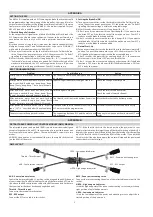
15
until the stabilo is fold. The wing will lose speed, stabilos behind, and
then recover speed before stabilizing. With this method, the sink rate is
around 5-6m/s.
We recommend you to always use the speed bar while using this
technique. You can control your trajectory the same way you would with
classic ears (weight shift). The first sensation will be a reduction of the
relative wind and a light back inclination, as if you were going backward.
To get out of this maneuver, you only have to release the lines as
you would with the classic method. The wing will shoot a bit before
returning to its normal sink rate. This is a very comfortable quick descent
technique that allows to avoid cravat risks while allowing easy turns. We
recommend you to try this maneuver for the first time in calm conditions
at a high height.
This new quick descent technique offers control and safety and does not
require a big training to be correctly performed.
5.3 SPIRAL DIVE
This is a more effective way to rapidly lose altitude. Beware that the wing
will experience and be subjected to a tremendous amount of descending
and rotating speed (g-force), which can cause a loss of orientation and
consciousness (blackout). This manoeuvre must therefore be done
gradually to increase one’s capacity to resist the g-force exerted on
the body. With practise, you will fully appreciate and understand it.
Only practise this manoeuvre at high altitude and with enough ground
clearance.
To start the manoeuvre, first weight shift and pull the brake handle
located on the inner side of the turn. The intensity of the turn can be
controlled by braking slightly using the outer brake handle.
A paraglider flying at its maximum rotating speed can reach –20 m/s, or
the equivalent of a 70 km/h vertical descent, and will stabilise in a spiral
dive from 15m/s onwards.
Good enough reasons to familiarise yourself with the manoeuvre and
understand how to exit it.
To exit this manoeuvre, the inner brake handle (down side of the turn)
must progressively be relaxed while momentarily applying tension to the
outer brake handle opposite to the turn. The pilot must also weight shift
and lean towards the opposite side of the turn at the same time.
The exit should be performed gradually and smoothly so that the
changes in pressure and speed can be noted.
When exiting the spiral, the glider will briefly experience an asymmetrical
acceleration and dive, depending on how the manoeuvre was carried out.
Practise these manoeuvres at sufficient altitude and carefully.
5.5 SLOW DESCENT TECHNIQUE
This technique allows descent without straining the wing or taxing the
pilot. Glide normally while searching for descending air and begin to turn
as if climbing in a thermal, but with the intention to sink.
Common sense has to be used to avoid dangerous areas of rotor when
looking for descending air. Safety first!
Summary of Contents for KLIMBER 2 P
Page 1: ...KLIMBER 2 P User s manual...
Page 19: ...19...
Page 22: ...10 3 RISERS PLAN 22...
Page 23: ...10 4 SUSPENSION PLAN 23...
Page 28: ...niviuk com...














































